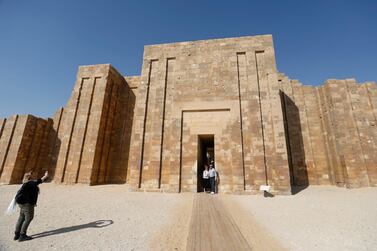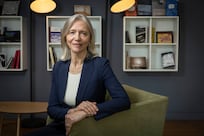Can you name five women artists?
It is a simple question – or it so seems – posed by the National Museum of Women in the Arts (NMWA). Every year since 2016, the organisation runs a social media campaign called #5WomenArtists during Women’s History Month to help highlight gender inequality in the art world.
It is an age-old issue that extends beyond art, and it persists. While figures in the Arab art world are scant, the numbers from the US and UK reveal a trend of underrepresentation for female artists, and even more for women of colour. In the US, for example, a 2018 analysis of 18 major US art museums found that their collections were 87 per cent male (and 85 per cent white).
Sharjah art collector Sultan Al Qassemi is trying to rectify this imbalance in a regional context through Barjeel Art Foundation's collection. The foundation, which he runs, has a major collection of modern Arab artworks, a number of which are on view at Sharjah Art Museum. The show is comprised of 50 per cent women.
Barjeel Art Foundation’s collection includes works by lesser-known Egyptian artist Menhat Helmy, Turkish-Jordanian painter Fahrelnissa Zeid and Syrian painter Zeinab Abdel Hamid.
In the contemporary art world, Arab women are also making their mark on a global stage. Here are five living female artists with roots in the region who are worth noting.
Etel Adnan

Known for her use of colour, Etel Adnan paints landscapes related to her native Lebanon. Born in 1925, she studied at French schools and later received her philosophy degree from the University of Paris. In her writings, Adnan would often reflect on her relationship to language, particularly Arabic, which she had not grown to speak fluently.

In her earlier works, she would paint directly onto the canvas using a palette knife or the paint tube, resulting in textured and vibrant compositions. Her abstract renditions of mountains and sky are also inspired by the landscape of Northern California, where Adnan lived for 50 years. She now resides in Paris.
Mona Hatoum

Mona Hatoum examines ideas of home and displacement through the lens of Palestinian exile. This is influenced by her own personal history, growing in Beirut to a Palestinian family. Her sculptures and installations often imbue violence, imprisonment and conflict – mesh cages, barriers and wires.
The artist has lived in the UK since the outbreak of the Lebanese civil war in 1975. She has had solo shows at the Tate Modern, Centre Pompidou, New Museum, and group shows at the Museum of Modern Art, Los Angeles County Museum of Art (LACMA) and Palais de Tokyo.
Larissa Sansour

Fusing science fiction and political commentary, the films and installations of Bethlehem-born Larissa Sansour have been included in major biennials. Last year, she represented the Dutch Pavilion at the 58th Venice Biennale, showcasing her latest work In Vitro.

Set in a bunker in post-apocalyptic Palestine, the film centres on a dialogue between two female scientists who discuss loss, memory and exile. Sansour’s films contain elements of science fiction, though her themes are invariably rooted to Earth, particularly Palestinian identity and the Israeli occupation.
Shirin Neshat
Gender and identity in the Muslim world is at the heart of Shirin Neshat’s work. Her career took off in the 1990s with her earlier photographic works that featured handwritten poetry transposed on women’s bodies.
Over the years, she has worked in photography and video installation and films. Her 2009 film Women without Women was awarded at the Venice Film Festival. In 2017, she produced Looking for Oum Kulthum, a drama about the iconic Egyptian singer.
Her latest solo exhibition at the Goodman Gallery in London – the first one she has had in 20 years – takes on a different topic. This time, Neshat explores the US, where she has lived for the last four decades, and American identity. The show is titled Land of Dreams.
Syrian artist Simone Fattal was born in Damascus and grew up in Lebanon. She fled the the country in 1980 because of the Civil War and lived in California, where she set up a publishing house. Her work spans both painting and sculpture.
Simone Fattal
Using ceramic, stoneware, bronze and porcelain, Fattal’s pieces are abstractly shaped so as to leave interpretation to the viewer. Her ceramic works, which we began making in 1988, explore archaeology and ancient history rendered in abstract forms. Fattal’s collages also reference history, including the break-up of the Ottoman empire and the destruction of heritage sites in Palmyra.

Her work has been shown at the Sharjah Art Foundation and more recently at the Museum of Modern Art (MoMA) PS1 in New York. Featuring nearly 200 sculptural works, the show was her first solo exhibition in the US.







